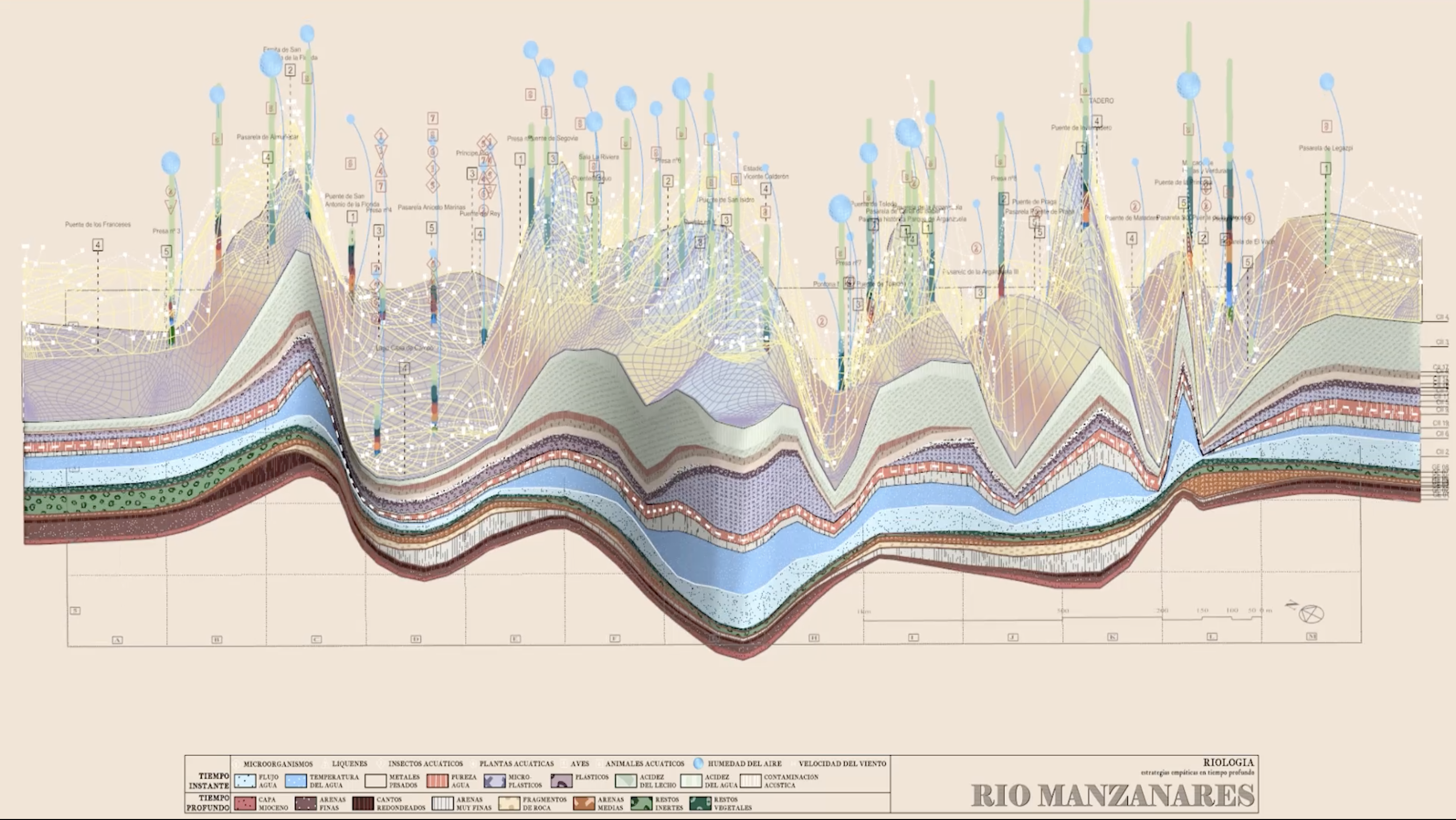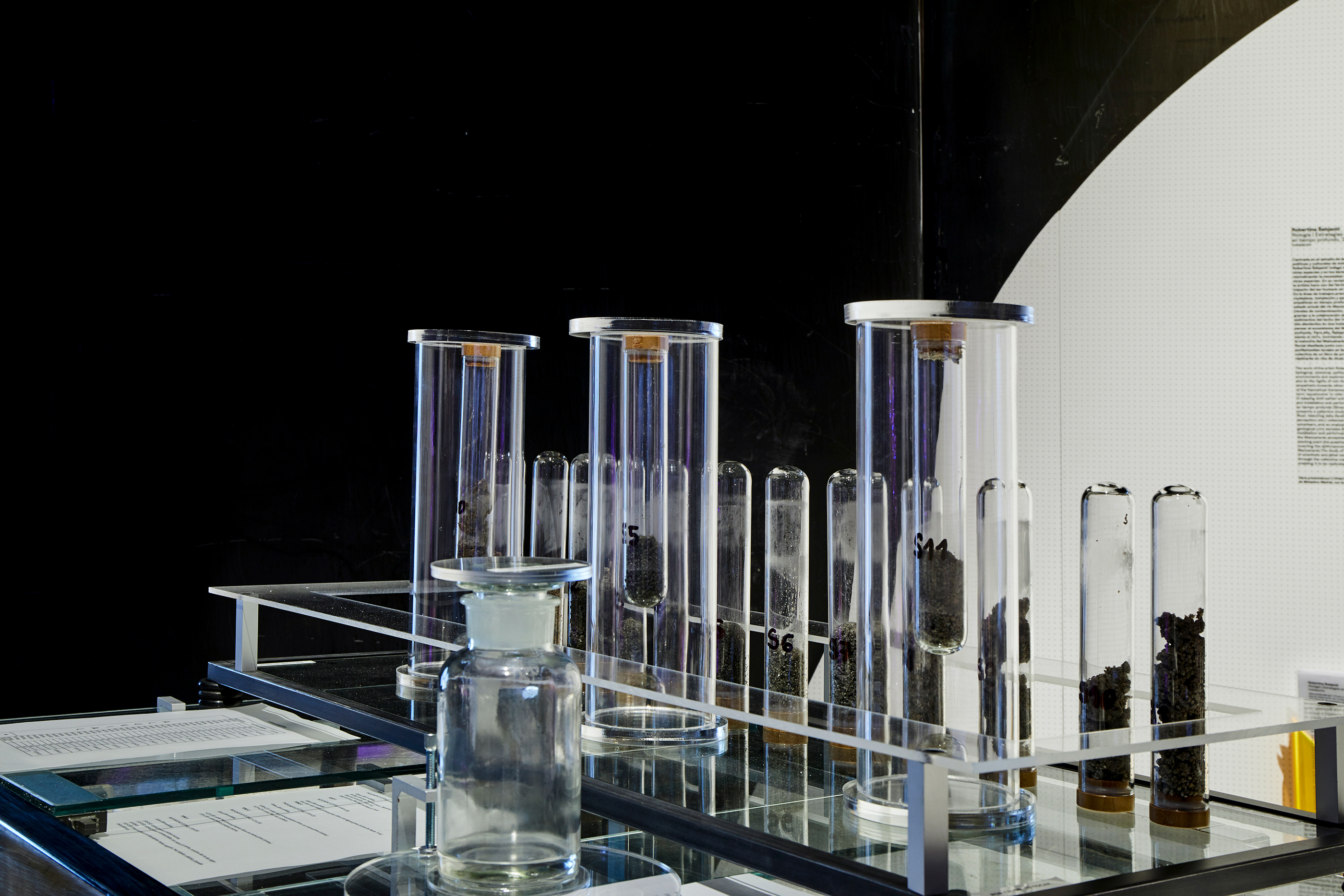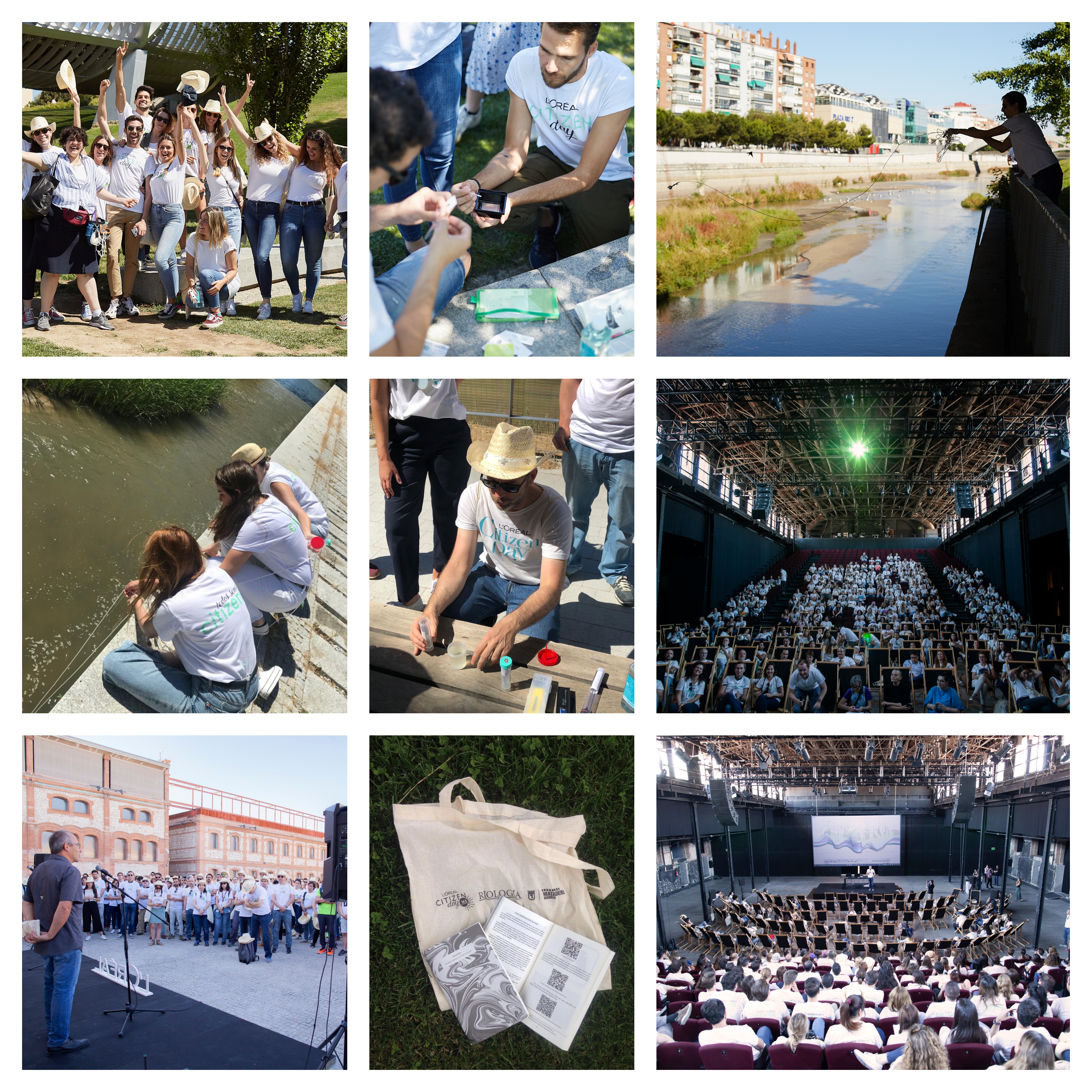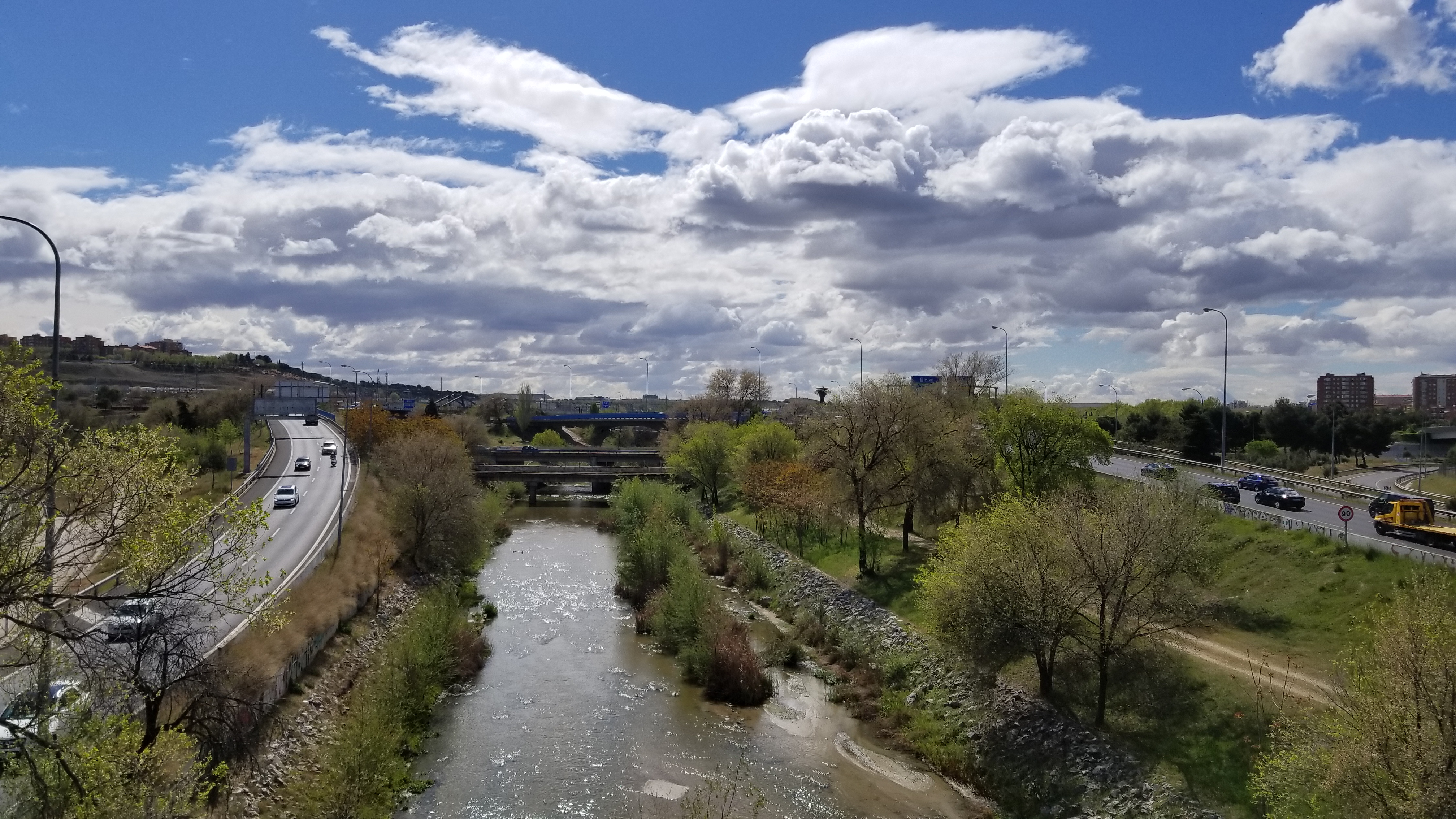Riología | Estrategias empáticas en tiempo profundo

The project focuses on the Manzanares River running through the city of Madrid and the renaturalisation programme with which the city authorities have aimed to return the river to its natural state and enable the restoration of as much biodiversity as possible of both its plant and animal species. Riología is essentially a transdisciplinary project in which the artist combines art, science and DIY principles. It comprises the findings of collective research on the current situation that was conducted within the framework of a one-day workshop, a book of protocols as well as sediment and odour samples. The workshop, conducted using the citizen science approach, was attended by 500 volunteers divided into 40 groups, with each group given a work area at one of the designated points along the selected 8-kilometre stretch of river. The results are summarised in an infographic that demonstrates the level of river contamination, biodiversity and the social perception of the river. The aim of the workshop was to observe the environment and collect data and, above all, to develop a strategy for bringing people closer to the environment in the sense of promoting empathy towards vulnerable natural habitats, such as rivers. In other words, it is of crucial importance not to leave all of environmental technical monitoring with state institutions, but rathe to include the public in performing measurements and thus encourage involvement at the individual level.
The second part of the project, in which the artist presents the ecosystem in deep time and takes us on a poetic journey into the past, focused on collecting samples of sediments from the riverbed and extracting an 8 metre deep geological core, from which an odour was distilled, allowing the visitors to enter into deep time.


Robertina Šebjanič
Riología | Empathic strategies in deep time, 2019
Realisation: L’Oréal and Instituto Mutante de Narrativas Ambientales de Matadero Madrid
In collaboration with: Fundación Ernesto Ventós, Biotopo Consultores, AGQ Labs, ZAP&BUJ, and ScenArt d.o.o.
Project coordination and management: Eduardo Castillo Vinuesa
Data visualisation: Paco Alfaro and Sergio del Castillo | MIAU_Infographics
Publication edited by: Robertina Šebjanič, Miranda Moss, Eduardo Castillo Vinuesa, and Amanda Masha Caminals
Graphic design: Natalia Molina Delgado and Eduardo Castillo Vinuesa
Acknowledgements: Gjino Šutić, Seo BirdLife Madrid, Ecologistas en acción, Mariano Cebrián, Marko Žavbi, the Plataform-A team, and especially the Manzanares River
https://www.mataderomadrid.org/en/node/33722
Project description
Riología | Empathic strategies of deep time by the artist Robertina Šebjanič is a complex project which questions the human relationship with non-human entities through various initiatives and actors. The project is divided into four parts: the citizen science action with 600 volunteers conducting an analysis of the Manzanares River’s ecosystem; the booklet Riología, created for the purposes of the aforementioned analysis and which converts the procedure of scientific-artistic research into a prototype; the artist’s performance visualising the data collected in the river; and the artwork presented here, exploring the river’s memory in deep time.
The idea of the river as “a frontier space” brought forth in the project Riología | Empathic strategies of deep time is embedded in the métier of the Mutant Institute of Environmental Narratives, which views the river as the axis of city transformation, and in the theoretical framework of “post-nature”. The aim of the project is to develop a model for a collective exercise of approaching the Manzanares River, one that will also serve as the basis for similar attempts at approaching other river ecosystems in the future.
Despite humanity’s undisputed relationship with and impact on ecosystems across the planet, when discussing “nature”, we insist on considering humans as not part of it. Since the beginning of the Capitalocene (1450–1750), a historical epoch underscored by commodity production and exchange (Moore, 2017), nature (and with it, sensitivity to whatever was not related to capital accumulation) came to be understood as an entity separate from human society and became an object of exploitation and study. “Nature” or, rather, the “environment” was associated with everything that existed beyond the limitations of human society and culture. Considering the term as a narrow historical concept, authors like Bruno Latour propose the idea of “post-nature” to signal the end of the dichotomy between nature and society. However, what happens once we can no longer keep “unspoiled nature” separate from human society? Can the knowledge of frontier spaces, such as river ecosystems in cities, contribute to changing our imaginaries and habits?
The theoretical framework of “post-nature” enables us to think about the idea of urban nature and the necessity to rethink some traditional ecological practices, such as nature conservation, in order to devote more attention to other aspects like the multifunctionality of ecosystems. The Manzanares River, the frontier space in which nature and the city have throughout history intertwined in various ratios, offers an ideal setting for reflecting on these questions and for assessing the impact that the Manzanares Renaturalisation Plan (2016) has had on the section of the river running through the city of Madrid.
Empathic strategies
Riología | Empathic strategies of deep time draws on the following question: “How does the river feel us?” Bearing in mind that, at the actual ecological site, it is of utmost importance to re-evaluate humanity’s place on Earth, Robertina Šebjanič launched this project with a view to reversing the anthropocentric logic with empathic strategies.
Just as most of the artists’ earlier works, Riología is an interdisciplinary project combining art, science, collective DIY actions, and citizen science. Through art, she develops cognitive questions and offers empathy as a strategy of approaching the river. With science, she uses analytical tools and predictive ecological models. And by applying the DIY principle and citizen science, she promotes empathic strategies, collects data, provides local viewpoints, thus deepening the knowledge about the patterns of change throughout history.
The action of investigating the river ecosystem, which the artist conceived in collaboration with the team from the Mutant Institute of Environmental Narratives as well as part of the Madrid and international scientific and artistic community aims to develop empathic strategies and analyses. The booklet Riología, undersigned by several authors, serves as a heterogeneous manual combining different kinds of knowledge and approaches. It presents various meditation practices and strategies to observe the river and in this way encourage a form of connecting with the environment that will help strengthen the respect for and understanding of one of the most delicate natural habitats in the world.
Deep time
Collectively, all of the earth’s rivers contain about 0.0001% of the earth’s water. Although that does not sound like very much, they play a crucial role by constituting one of the main sources of water necessary for the survival of all life forms on the planet. Rivers are dynamic water bodies that are constantly changing, modifying the landscape and their own channels, with changes taking place both in space and time. Drawing on rivers’ capacity to mutate in space and time, Riología | Empathic strategies of deep time refers to long-term processes and the deep time of river ecosystems. In doing so, it builds on the scientific definition of the term “deep time”, which not only alludes to the geological time of an ecosystem, but it also appeals to the need to readjust humanity’s perception of its temporality. On its multiple levels, the project champions the notion of the deep time of our environment and its historical development, as well as the ability to understand beyond the hic et nunc of ecosystems.
MUTANT INSTITUTE OF ENVIRONMENTAL NARRATIVES MATADERO MADRID
Whereas Robertina Šebjanič enacts empathic strategies to approach the river with an action of citizen science, her installation exhibited here visualises the deep time of the Manzanares River. The presented columns testify to how the profiles of geological cores or sediment strata accumulated over time. By transforming the geological cores into odours, the artist presents smell as the sense that is most strongly connected with human memory. In this way, she also invites us to readjust our senses and embrace strategies to empathise with non-human entities in order to understand our own relationship towards ecosystems when our generation will be long gone.

Robertina Šebjanič
Riología | Empatične strategije globokega časa, 2019
Realizacija: L’Oréal in Instituto Mutante de Narrativas Ambientales de Matadero Madrid
V sodelovanju: Fundación Ernesto Ventós, Biotopo Consultores, AGQ Labs, ZAP&BUJ in ScenArt d.o.o.
Koordinacija in vodenje projekta: Eduardo Castillo Vinuesa
Vizualizacija podatkov: Paco Alfaro in Sergio del Castillo | MIAU_Infographics
Knjižico uredili: Robertina Šebjanič, Miranda Moss, Eduardo Castillo Vinuesa in Amanda Masha Caminals
Grafično oblikovanje: Natalia Molina Delgado in Eduardo Castillo Vinuesa
Posebne zahvale: Gjino Šutić, Seo BirdLife Madrid, Ecologistas en acción, Mariano Cebrián, Marko Žavbi, ekipa Plataform-A in še posebej reka Manzanares
https://www.mataderomadrid.org/en/node/33722
Opis projekta
Riología | Empatične strategije globokega časa umetnice Robertine Šebjanič predstavlja kompleksen projekt, ki skozi različne pobude in akterje prevprašuje človekov odnos do nečloveških entitet. Sestavljajo ga štirje deli: akcija državljanske znanosti z udeležbo 500 prostovoljcev, ki so opravili analizo ekosistema reke Manzanares; knjižica z naslovom Riología, ki je nastala za omenjeno analizo in ki nadgrajuje postopek znanstveno-umetniške raziskave v prototip; vizualizacije v reki zbranih podatkov; in tu razstavljeno umetniško delo, ki preiskuje spomin reke v globokem času.
Ideja reke kot »mejnega prostora« v projektu Riología | Empatične strategije globokega časa je zajeta v temeljni dejavnosti Mutacijskega inštituta za okoljske pripovedi, ki reko pojmuje kot os transformacije mesta, in v teoretičnem okviru »po-narave«. Namen projekta je razviti model kolektivne vaje v približevanju reki Manzanares, ki bo služil kot podlaga za podobne akcije približevanja drugim rečnim ekosistemom v prihodnosti.
Kljub neizpodbitnemu odnosu in vplivu, ki ga ima človeštvo na ekosisteme po vsem svetu, med razpravljanjem o »naravi« vztrajamo pri razmisleku o človekovem obstoju zunaj nje. Že od samega začetka kapitalocena (1450–1750; Moore, 2017), zgodovinskega obdobja, ki sta ga prvenstveno zaznamovala proizvodnja in izmenjava dobrin, se je uveljavilo razumevanje narave (in z njo občutljivosti na dejavnosti, ki niso povezane s kopičenjem kapitala) kot entitete, ki je ločena od družbe, narava sama pa je postala predmet izkoriščanja in proučevanja. »Narava« oziroma »okolje« se je povezovalo z vsem, kar je obstajalo onstran omejitev človeške družbe in kulture. Upoštevaje izraz kot zgodovinsko ozek koncept, avtorji, kot je Bruno Latour, predlagajo idejo »po-narave«, ki nakazuje konec dihotomije med naravo in družbo. Toda kaj se zgodi, ko »neokrnjene narave« ne moremo več ohraniti ločene od človeške družbe? Ali lahko poznavanje mejnih prostorov, kot so rečni ekosistemi v mestih, pripomore k spremembi naših imaginarijev in navad?
Teoretični okvir »po-narave« omogoča premislek o ideji urbane narave ter nujnosti vnovičnega razmisleka o nekaterih tradicionalnih ekoloških praksah, kot je ohranjanje narave, da lahko več pozornosti namenimo drugim vidikom, npr. multifunkcionalnosti ekosistemov. Manzanares, mejni prostor, v katerem sta se narava in mesto skozi zgodovino prepletala v različnih razmerjih, ponuja idealno prizorišče za refleksijo o teh vprašanjih in oceno učinka, ki ga ima Načrt za renaturalizacijo reke Manzanares na odseku, ki teče skozi Madrid (2016).
Empatične strategije
Projekt Riología | Empatične strategije globokega časa si v izhodišču zastavlja vprašanje: »Kako nas reka občuti?« Upoštevajoč, da je ključnega pomena opraviti vnovično oceno položaja človeštva na Zemlji na samem ekološkem prizorišču, je Robertina Šebjanič projekt zasnovala v želji, da antropocentrično logiko zaustavi s pomočjo empatičnih strategij.
Tako kot večina umetničinih zgodnejših del je tudi Riología interdisciplinaren projekt, ki združuje umetnost, znanost, kolektivne akcije po načelu »naredi sam« ter državljansko znanost. Skozi umetnost razvija zaznavna vprašanja in ponuja empatijo kot strategijo približevanja reki. Iz znanosti črpa analitična orodja in napovedne ekološke modele. S poudarkom na upoštevanju načel »naredi sam« in državljanske znanosti pa širi empatične strategije, zbira podatke, podaja lokalna stališča in tako poglablja poznavanje vzorcev sprememb skozi zgodovino.
Namen akcije proučevanja rečnega ekosistema, ki jo je umetnica zasnovala v sodelovanju s skupino z Mutacijskega inštituta za okoljske pripovedi ter delom madridske in mednarodne znanstvene in umetniške skupnosti, je razvijanje empatičnih strategij in analiz. Knjižica z naslovom Riología, pod katero se je podpisalo več avtorjev, služi kot heterogeni priročnik, v katerem se prepletajo znanja in pristopi. Knjižica predstavlja raznovrstne prakse meditacije in strategije opazovanja reke, njen namen pa je spodbuditi obliko povezovanja z okoljem, s pomočjo katere bo mogoče okrepiti spoštovanje in razumevanje enega najobčutljivejših naravnih habitatov na svetu.
Globoki čas
Vse reke tega sveta skupaj predstavljajo okoli 0,0001% zemeljskih voda. Čeprav ne zveni ravno veliko, igrajo reke ključno vlogo, saj predstavljajo enega glavnih virov vode, ki je potrebna za preživetje vseh živih bitij na tem planetu. Reke so dinamična, stalno spreminjajoča se vodna telesa, ki vedno znova preoblikujejo pokrajino ter lastne kanale, povzročene spremembe pa potekajo tako v prostoru kakor v času. Na podlagi te zmožnosti rek, da mutirajo v prostoru in času, se projekt Riología | Empatične strategije globokega časa ukvarja z dolgoročnimi procesi in globokim časom rečnih ekosistemov. Pri tem izhaja iz znanstvene definicije izraza »globoki čas«, ki aludira na geološki čas nekega ekosistema, obenem pa opozarja na nujnost prilagoditve v človekovem dojemanju njegove začasnosti. Projekt na več ravneh uveljavlja pojem globokega časa našega okolja in njegovega zgodovinskega razvoja ter zmožnost razumevanja, ki sega onkraj stanja ekosistemov tukaj in zdaj.
MUTACIJSKI INŠTITUT ZA OKOLJSKE PRIPOVEDI MATADERO MADRID
Medtem ko z akcijo državljanske znanosti umetnica udejanji empatične strategije približevanja reki, tu predstavljeno delo vizualizira globoki čas reke Manzanares. Razstavljene kolumne profilov iz rečne struge odvzetih geoloških jeder oziroma plasti sedimentov pričajo o tem, kako so se ti nalagali skozi čas. S transformacijo geoloških jeder v vonjave umetnica predstavi vonj kakor čut, ki je najbolj povezan s človekovim spominom. Na ta način nas tudi vabi, da prilagodimo svoje čute in sprejmemo strategije izkazovanja empatije do nečloveških entitet, da bomo razumeli lasten odnos do ekosistemov v časih, ko naše generacije že davno ne bo več.

|
Robertina Šebjanič
Riología | Estrategias empáticas en tiempo profundo, 2019
Obra producida por: L’Oréal y el Instituto Mutante de Narrativas Ambientales de Matadero Madrid.
Con la colaboración de: Fundación Ernesto Ventós, Biotopo Consultores, AGQ Labs, ZAP&BUJ y SceenArt d.o.o.
Coordinación de proyecto y responsable de producción: Eduardo Castillo Vinuesa
Visualización de datos: Paco Alfaro y Sergio del Castillo | MIAU_Infographics
Publicación editada por: Robertina Šebjanič, Miranda Moss, Eduardo Castillo Vinuesa y Amanda Masha Caminals
Diseño gráfico de publicación: Natalia Molina Delgado y Eduardo Castillo Vinuesa
Agradecimientos a: Gjino Šutić, Seo BirdLife Madrid, Ecologistas en acción, Mariano Cebrián, Marko Žavbi, al equipo de la
Plataform-A y en especial al Río Manzanares
https://www.mataderomadrid.org/en/node/33722
Descripción del proyecto
Riología | Estrategias empáticas en tiempo profundo de la artista Robertina Šebjanič es un proyecto complejo que cuestiona, a través de varias iniciativas y agentes diversos, la relación que el ser humano establece con entidades no humanas. El proyecto se compone de cuatro partes: una acción de ciencia ciudadana con 600 voluntarios para el análisis del ecosistema del río Manzanares; la publicación Riología producida para dicho análisis y que prototipa el proceso de investigación científico-artística; una performance de la artista para la visualización de los datos recogidos en el Manzanares; y la obra de arte que se presenta en este espacio e indaga en la memoria del río en tiempo profundo.
La idea de «post-naturaleza» y el río como «espacio frontera» Riología | Estrategias empáticas en tiempo profundo se enmarca en la línea de trabajo del Instituto Mutante «El río como eje de transformación de la ciudad» y en el marco teórico de la «post-naturaleza». Se plantea como un ejercicio colectivo de aproximación al Manzanares pero también a otros ecosistemas fluviales para futuras acciones.
A pesar de la evidente relación e impacto de nuestra especie en los ecosistemas del planeta, al hablar de «naturaleza» insistimos en considerar a los seres humanos ajenos a ésta. Desde los inicios de la era histórica dominada por la producción e intercambio
de comodidades o Capitaloceno —fechado entre el 1450 y el 1750 (Moore, 2017)— la naturaleza (y con ella las sensibilidades ajenas a la acumulación del capital) pasó a entenderse como un ente separado de la sociedad, convirtiéndose en objeto de explotación y estudio. La «naturaleza» o «medio ambiente» se asoció con todo aquello más allá de los límites de sociedad y cultura humana. Considerando el término como un concepto históricamente estrecho, autores como Bruno Latour proponen la idea de «post-naturaleza» para indicar el fin de la dicotomía entre naturaleza y sociedad. Pero ¿Qué pasa cuando ya no podemos
separar la «naturaleza virgen» de nuestra sociedad humana? ¿Puede el conocimiento de espacios frontera como los ecosistemas fluviales en ciudades ayudar a modifica nuestros imaginarios y costumbres?
El marco teórico de la «post-naturaleza» permite pensar en la idea de naturaleza urbana y en la necesidad de replantear algunas prácticas ecológicas tradicionales, como la de conservación, para prestar más atención a otros aspectos como la multifuncionalidad de los ecosistemas. El rio Manzanares, un lugar frontera donde naturaleza y ciudad se han mezclado en proporciones variables a lo largo de la historia, es un escenario perfecto para reflexionar sobre estas cuestiones y evaluar el impacto del Pan de renaturalizacion del río Manzanares a su paso por la ciudad de Madrid del Ayuntamiento (2016).
Estrategias empáticas
El punto de partida de Riología | Estrategias empáticas en tiempo profundo surgió de la pregunta «¿Cómo nos siente el río a los seres humanos?». Teniendo en cuenta que en el escenario ecológico actual es imprescindible que reevaluemos el lugar del ser humano en la Tierra, Šebjanič plantea el proyecto desde la voluntad de invertir la lógica antropocéntrica con estrategias empáticas.
Como en la mayoría de obras anteriores de la artista, Riología se plantea desde un enfoque interdisciplinar que integra arte, ciencia y prácticas comunitarias DIY —de las siglas «hazlo tú mismo» en inglés— y de ciencia ciudadana. A través del arte formula preguntas de percepción y propone la empatía como aproximación al río. Desde la ciencia hace uso de herramientas de análisis y modelos de predicción ecológica. Con el enfoque DIY y la ciencia ciudadana, difunde las estrategias empáticas recopila datos y hace observaciones a nivel local para profundizar el conocimiento histórico de los patrones de cambio.
La acción de estudio del ecosistema fluvial diseñada junto con el equipo del Instituto Mutante de Narrativas Ambientales y parte de la comunidad científica y artística de Madrid e internacional nace con la intención de desarrollar dichas estrategias empáticas y de análisis. Escrito a varias manos, el libro Riología se presenta como manual heterogéneo que entrelaza saberes y aproximaciones. En el libro se presentan distintas prácticas como la meditación y estrategias de observación del río. La intención es la de estimular una forma de relacionarnos con el entorno que ayude a fomentar el respeto y la conciencia hacia uno de los hábitats naturales más delicados del planeta.
Tiempo profundo
En conjunto, todos los ríos de la Tierra contienen aproximadamente el 0,0001 % del agua del planeta. No parece mucho pero tienen un papel de enorme importancia, ya que son una de las principales fuentes de agua para la supervivencia de las especies del Planeta. Los ríos son cursos de agua dinámicos, en continuo cambio, que modifican el paisaje y sus propios cauces a través de cambios que se producen tanto en el espacio como en el tiempo. Partiendo de esta capacidad de mutación en el espacio- tiempo de los ríos, Riología | Estrategias empáticas en tiempo profundo hace referencia a los procesos de larga duración al tiempo profundo de los ecosistemas fluviales. El proyecto se plantea desde la definición científica del término «tiempo
profundo», que alude al tiempo geológico de un ecosistema, pero también apela a la necesidad de reajustar la percepción humana a esa temporalidad. En sus múltiples capas, el proyecto reivindica una noción temporal profunda de nuestro entorno y su devenir histórico. Un sentir para una comprensión que supere el aquí y ahora de los ecosistemas.
INSTITUTO MUTANTE DE NARRATIVAS AMBIENTALES MATADERO MADRID
Mientras que en la acción de ciencia ciudadana, la artista pone en práctica las estrategias empáticas de aproximación al río, la pieza que se presenta en este espacio visibiliza el tiempo profundo del Manzanares. Los testigos geológicas o estratos de sedimentos del lecho del río de las columnas que se muestran, dan fe del paso de los sedimentos en el tiempo. Con la traducción de los testigos a esencias, la artista hace referencia al olfato como el sentido más conectado a la memoria en los seres humanos. Propone, así, reajustar nuestros sentidos y adoptar estrategias empáticas con entidades no humanas para entender nuestra relación con los ecosistemas en tiempos que exceden con creces nuestra generación.